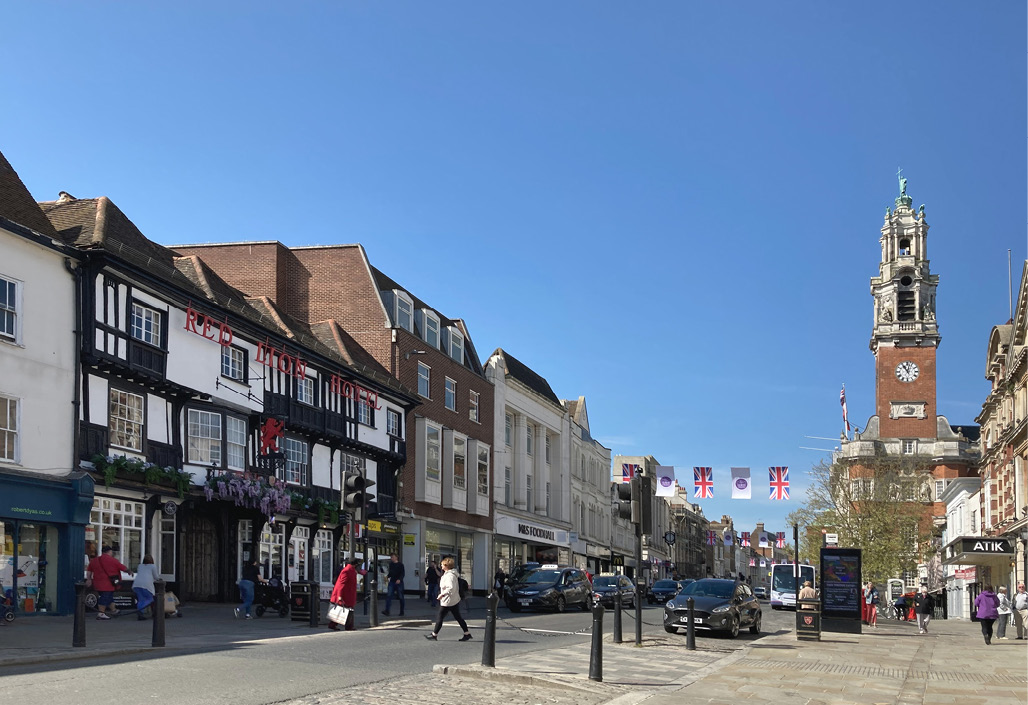Colchester City Centre Masterplan SPD
(17) Executive Summary

The Colchester City Centre Masterplan sets out a clear vision for the future development of Colchester city centre for years to come. This document has been informed by a period of in-depth research and engagement.
Colchester city centre is the focal point of a rapidly growing city with a high-quality historic environment. Colchester’s rich heritage, collection of cultural organisations, educational institutions and growing creative and digital sectors are all positive elements that contribute to the city’s unique identity and have a role to play in the future of its city centre.
The city centre currently faces environmental and economic challenges. Environmentally, it suffers from vehicular congestion and air pollution and is difficult to access by sustainable means of travel.
The centre is not immune from national trends in retail, and whilst some areas benefit from vibrant, independent high street businesses, larger national chains have been closing stores or relocating in recent years. An over-reliance on retail and hospitality jobs has created a low wage economy locally, by comparison with other regional centres.
Colchester was the UK’s first city, and regained its status in 2022 to become one of its newest, too. It has all the potential to meet the twin challenges of the climate emergency and wider economic trends with bold, yet pragmatic, approaches.
Together, the proposals in this plan will support Colchester’s development over the coming decades, with a respect for its past and ambition for its future.
The City Centre Masterplan delivers on this vision by proposing interventions at three different scales: The masterplan itself, which takes a look at the wider city centre area, urban design strategies, which focus in more detail on the retail core of the city centre, and design frameworks for key sites. The series of design frameworks that have been developed are supported by a delivery plan.
Taken together the proposals set out throughout this document lay the foundations for a bold, sustainable future for the Colchester’s City Centre.
The interventions outlined in this document are driven by the following themes:
Actively respond to the climate emergency
Reducing pollution and carbon emissions by providing ways for nearby communities to travel to the city centre by walking, cycling and public transportation. This includes providing spaces for residents to park their cars on the periphery of the city centre and switch to more sustainable travel options while moving around the city centre.
Provide a safe, healthy, active and accessible city centre
Integrating improvements to the public realm with increased cycle access and enhanced pedestrian experience of the city centre, including for those with different abilities.
Diversify city centre uses to encourage footfall
Providing frameworks for future development in the city centre. With the appropriate land use and built form parameters, new uses such as housing can be introduced into the city centre in a contextually-sensitive and economically beneficial way.
Support the city centre economy to everyone’s benefit
Guiding the future economy of the city centre, creating a framework for diversifying uses away from a reliance on retail by strengthening the existing cultural, workspace and evening offer to re-energise the city centre’s economy.
Make the most of Colchester’s rich heritage
Uplifting Colchester’s heritage assets by improving their setting and allowing them to be experienced as ‘more than the sum of their parts’. It also aims to ensure new development is integrated well into the existing historic city centre.
Vision
Colchester was the UK’s first city, and regained its status in 2022 to become one of its newest, too. It has all the potential to meet the twin challenges of the climate emergency and wider economic trends with bold, yet pragmatic, approaches.
Together, the proposals in this plan will support Colchester’s development over the coming decades, with a respect for its past and ambition for its future.
Colchester’s heritage should be source of pride for residents, and attract visitors from across the region and the country. Development of the city centre must create quality streets and spaces that provide the perfect setting for historic buildings, and make a walkable, enjoyable environment for everyone.
The city centre economy should be amplified with more diverse activities, including markets, community uses, independent retail and food and drink, and workspace for the creative and digital sector. This will create more high quality jobs in the city centre and sustain other businesses in turn.
People living in the city centre also sustain local businesses and make it a lively and vibrant place. Good quality and affordable homes, tapping into the appeal of city centre living, will support local shops and services, and the transition to low-carbon lifestyles.
As many people as possible should walk, cycle or use public transport to travel into the city centre. This is critical for reducing carbon emissions, improving air quality, and making the city a more pleasant place to spend time. This means re- connecting neighbourhoods to the city centre with attractive and easy walking and cycling routes; and improving public transport, particularly bus provision and including the new Rapid Transit System.
Reducing unnecessary traffic will mean that people who still need to travel into the city centre by car, will be able to do so more reliably. They should be able to park in safe and accessible locations, or be dropped off and picked up easily. Deliveries to and from businesses, by day and night, must be fully considered, along with improving the interchanges between different modes of transport.


